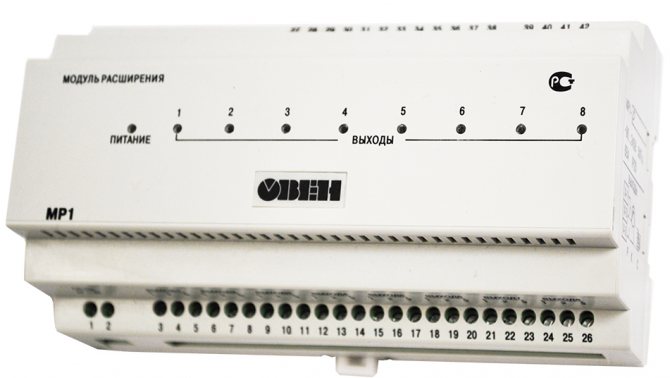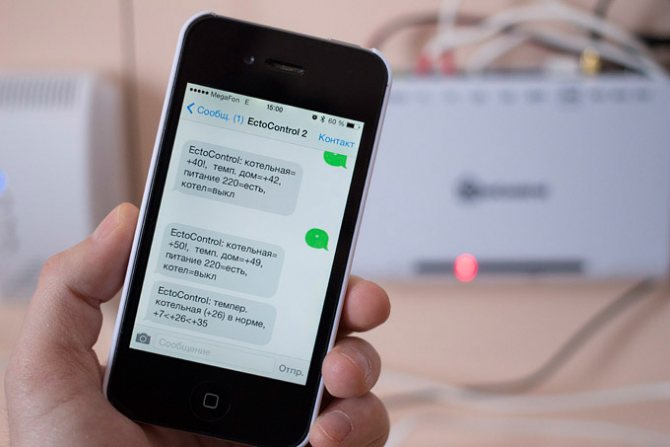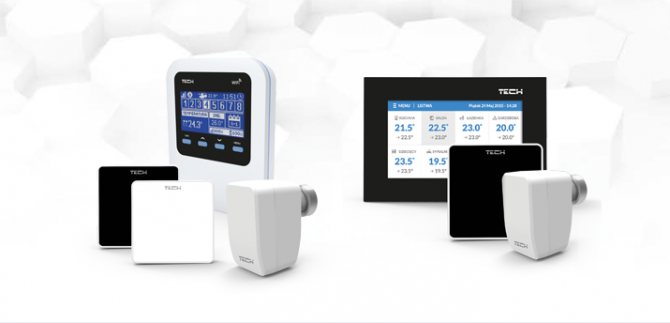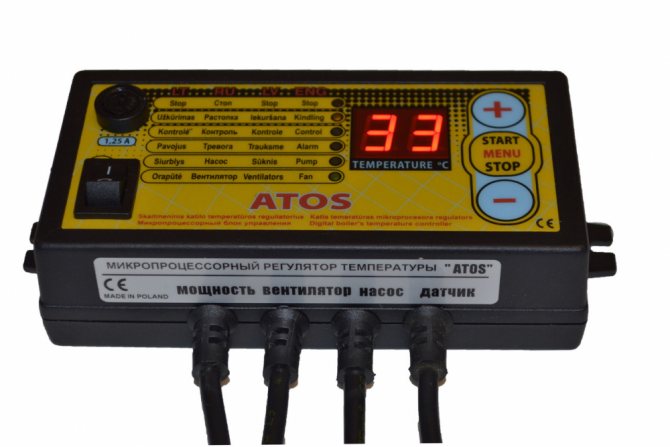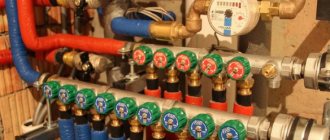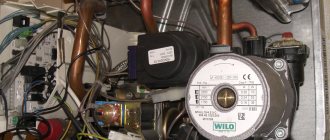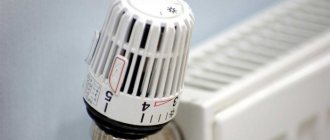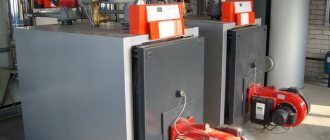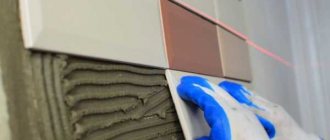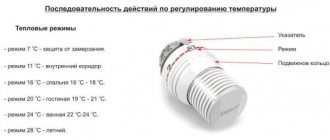The principle of operation and functions of automation for solid fuel boilers
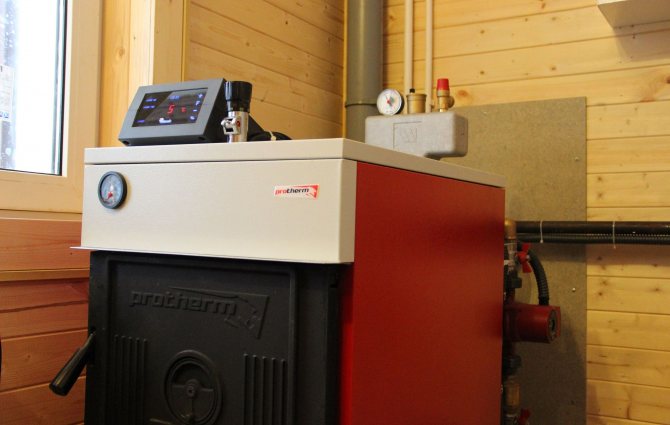
Retrofitted automatic control unit on TT boiler.
Automatic control can be both volatile and non-volatile. In modern solid fuel models, a non-volatile option - a draft regulator - is installed from the factory and works according to the principle of expansion when heated: the temperature-sensitive metal heats up when the temperature in the boiler rises and mechanically covers the blower, reducing the combustion rate (and vice versa).
The non-volatile option (requiring connection to the mains) is more efficient and multifunctional. A standard set of automation for solid fuel boilers consists of two main elements:
- fan - installed in the bottom of the boiler, on the door of the air supply (blower) or ash pan, it is used to force air into the combustion chamber. The intensity of combustion depends on the volume of incoming air.
- controller - electronic control unit that sets the fan speed. At maximum speed of rotation, the maximum volume of air is supplied to the combustion chamber and the most intensive combustion is maintained. When the minimum temperature requirements are set, the minimum rotation speed of the blower is maintained or it is assumed to be completely stopped.
The controller and fan can be purchased either as a ready-made kit or separately. However, they only work in pairs. Also, most controllers support control of a circulation pump, a smoke exhauster, it is possible to control it using a room thermostat, and organize weather-dependent control. The most functional models have a built-in GSM module.
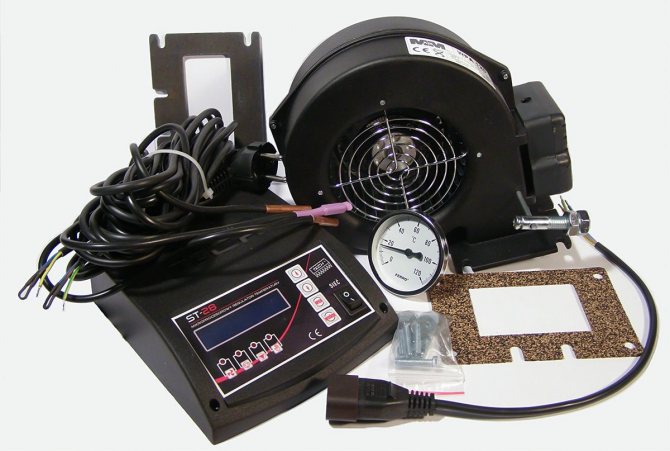

A ready-made complete set of automation.
As a result, the functions of the automation kit are:
- increasing the efficiency of fuel combustion (boiler efficiency) by controlling the blowing;
- stable maintenance of the set temperature or its change depending on the set settings of the room thermostat;
- automatic ignition (optional, in the presence of an igniter);
- increase in the duration of combustion of one load of fuel.
In this case, there is no division according to the types of fuel used. One set of automation can work with both coal and wood or pellet boilers.
Automatic fuel supply
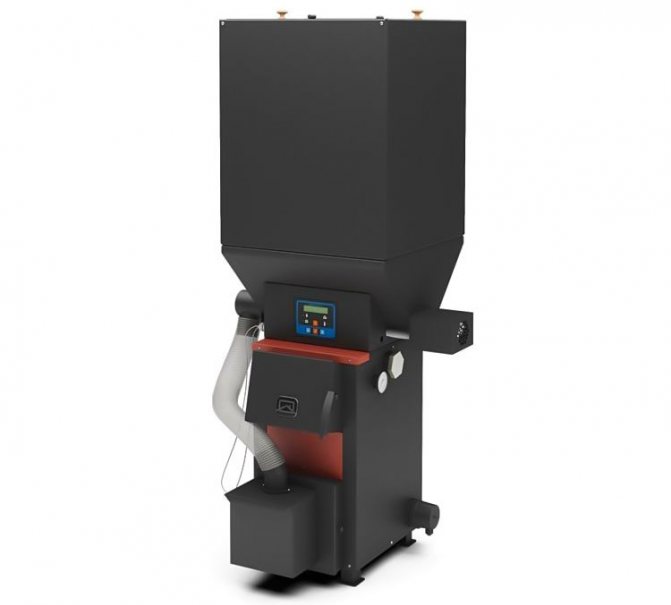

Separately, it is worth highlighting the automatic fuel supply systems, their work can also be controlled by some of the controller models. The autoloading system is, most often, a bunker with fuel (wood, coal, pellets, peat), installed on the boiler or next to it. Fuel from it can be supplied by means of: embankment (falling under its own weight), auger (gear-screw mechanism), conveyor belt. In any case, the feed system is controlled by the controller.
The use of an automatic feeding system solves the issue of low autonomy, since one loading of the bunker is enough for continuous operation of the boiler for 2-30 days, depending on the volume of the bunker and the intensity of combustion.
Are pellet boilers with automatic fuel supply worth the money?
Distinctive features
- the controller is equipped with an LCD display;
- the ability to select one of four pump operating modes: home heating, boiler priority, parallel pumps, summer mode;
- joint operation of the TECH ST-48 controller with a two-position room thermostat or thermostat with RS communication is provided;
- fan control;
- feeding device control;
- central heating pump control;
- hot water pump control;
- underfloor heating pump control;
- recirculation pump control;
- the ability to connect the TECH ST-505 Ethernet or WiFi RS internet module;
- the ability to control two valves using additional modules i-1, i-1m, ST-431n; weekly control (option);
- impulse handle;
- central heating temperature sensor (installed on the boiler flow);
- hot water supply temperature sensor (installed in the hot water tank);
- underfloor heating temperature sensor (installed in the heating circuit);
- boiling protection - thermal (installed on the boiler supply line);
- temperature sensor on the feeder (thermostat to protect the fuel supply system from backfire);
- the body is made of metal material and is intended for flush-mounted installation in the boiler.
Reviews on the use of household automation kits: advantages and disadvantages
| Benefits | disadvantages |
| Increased efficiency - carried out due to precise adjustment of the blowing, stable heat output throughout the entire combustion (as opposed to the peak values during intensive combustion and the minimum values during the afterburning period with a standard boiler design) | Additional noise - the operation of the fan assumes the presence of additional sounds, however, according to the owners' reviews, the noise is practically inaudible even through the thin walls of the boiler room. |
| Fuel savings - less fuel is required to achieve the same heating capacity, a huge part of the excess heat does not "fly into the chimney" | Additional costs - the cost of a standard set "controller + fan" is on average 7-11 thousand rubles. If desired, a room thermostat (about 1-3 thousand rubles), an auto-feed system (from 10 thousand rubles) |
| Maintaining a constant temperature | Volatility - for the boiler to work, it will need to be connected to the mains |
| Automatic ignition and extinguishing (optional) | |
| Possibility of external control - by connecting a room thermostat or outdoor sensors, the automation will be guided not by the temperature of the coolant, but by the temperature in the room or outside, which is more efficient and comfortable | |
| Increasing the burning time of one bookmark, the ability to connect an auto-feed system | |
| Safety - most controllers are equipped with protection against overheating or stopping the circulation pump |
What is a gas boiler control unit
The gas boiler control unit (CU) is a device that regulates, optimizes and monitors the operation of the heater with maximum accuracy. This device is equipped with the function of programming preset operating modes, sensors that capture all changes in readings and supply these data to the control unit.
The main functions assigned to the boiler control unit:
- burner operation control;
- gas supply regulation:
- ensuring the supply of heat;
- chimney draft control;
- turn off the gas supply if the maximum temperature is reached;
- turn on the gas supply at the mark at the minimum temperature.
The first pump-water heating device in Russia was tested in the early years of the 19th century when heating the Mikhailovsky Theater in St. Petersburg. After a successful experiment, the systems were installed in the Hermitage, the Mariinsky Theater and the Engineering Institute of Communications.
The best known manufacturers and models: characteristics and prices
ATOS + WPA 120
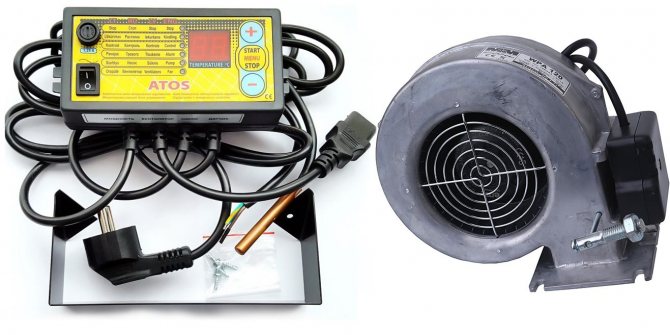

One of the best and most common sets of automation for a solid fuel heating boiler.
The ATOS controller has an extremely wide functionality, a considerable number of adjustable operating parameters and an affordable cost.In addition to the standard functions, there is: frost protection for the heating system; notification of temperature drop or overheating, lack of fuel; LED indicators of the circulation pump and fan operation; adjustable hysteresis. For the practice of operation it is also known for its reliability. Manufacturer: KOM-STER, Poland.
The blower M + M WPA 120 is also the most common, time-tested Polish model. Designed to work with boilers with a capacity of 25-50 kW. There are other versions on the market for more or less powerful boilers.
Kit cost: RUB 8,900-10,000
Boilers with a burning time of one fuel tab up to 7 days
COMFORT-ECO + NWS-100
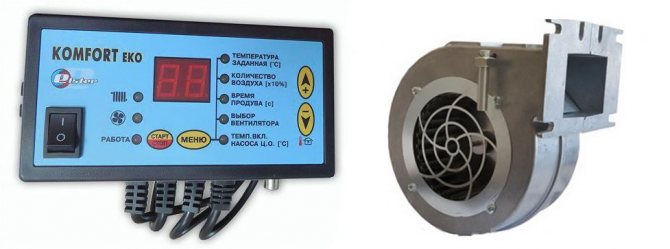

The controller is another Polish model: with almost the same functionality and reliability for an even more modest price. The functionality implies the presence of all safety functions, the ability to connect a room thermostat and outdoor sensors, control of a circulation pump (but not DHW). Differs in the presence of an anti-failure filter and an overload fuse.
The Nowosolar NWS-100 turbine is a simple Polish aluminum model, one of the most inexpensive on the market. It has an unremarkable standard design and is known for its quality assembly and reliability. The model is designed for installation in boilers with a capacity of 30-50 kW.
Kit cost: RUB 8,500-9,800
Tech ST24 + WPA 120


The controller is a hassle-free, simpler model, equipped with only standard functions: control of the blower fan speed, control of the circulation pump, LED indication of the operation of the elements. Installation of external sensors and automatic feeding systems is also not provided. An excellent choice, but at a price comparable to more functional models. The fan is the most common model already described above.
Kit cost: 9 200-10 500 rubles.
KG Elektronik CS-18S + DP-120
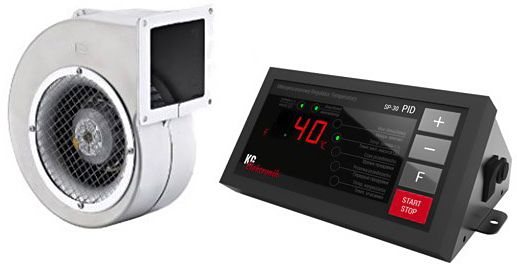

Polish controller KG Elektronik CS-18S is one of the most modern and functional on the market. Differs in the presence of a touch screen control, the ability to control the fan, circulation pump, hot water supply, automatic supply system. The hot water pump can be made a priority; there are also special modes adapted for each type of fuel: wood, wood and coal, coal, sawdust. All existing protective mechanisms are also provided: from overheating and freezing, stopping the circulation pump.
The KG Elektronik CS-18S + DP-120 fan is also one of the best. It features an asynchronous motor and high performance with a relatively low noise level up to 63-65 dB. It has a metal outlet flap that blocks the return flow of exhaust gases.
Kit cost: 11,000-12,500 rubles.
Boiler control automation
The modernized control system greatly facilitates the use of home and industrial boiler equipment.
The main components of the control unit are:
- blower fan;
- controller;
- draft regulator;
- circulation pump.
Additionally, they can be equipped with water level sensors, fuel level and fuel consumption sensors, pressure recorders, safety valves, as well as an alarm that is triggered if the temperature level exceeds the permissible installation range (25-50 ° C).
Principle of operation
The automation for heating devices works simply and clearly:
- controls the blowing;
- controls the entire volume of air entering the combustion chamber;
- ensures optimal combustion.
Unlike previous models, in the new improved devices there is no need to constantly manually open the ash pan door and monitor the temperature using a thermometer. For this they have a draft regulator.It is a very convenient volatile device that automatically opens and closes the door in accordance with the temperature of the water contained in the container.
Instead of a standard damper, a fan controlled by the controller is installed. Its task is to supply exactly as much air into the combustion chamber as is necessary for full and safe work.
The preferred level of the coolant temperature is set using a controller with a screen and a remote control panel. In order for the temperature regime to be maintained in accordance with the climatic conditions of the street, you can install an additional system with remote controllers and outdoor air sensors.
The fuel is ignited using an electric glow plug built into the burner.
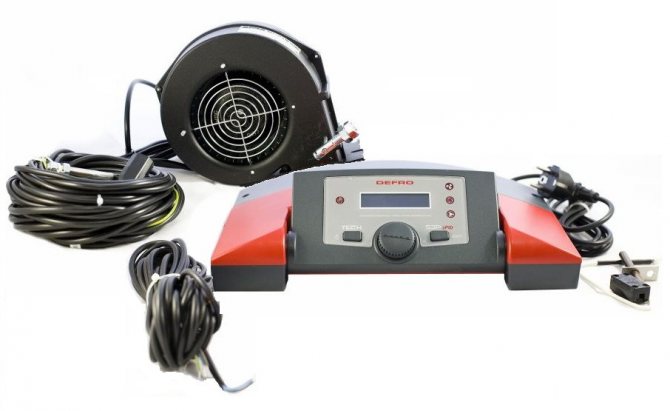

Advantages and disadvantages of using
A small number of sensors and tools controls the combustion process of any type of solid fuel, maintains the temperature set by the owner and guarantees safety.
The most important useful features and benefits of using automation include:
- rational and economical consumption of solid fuel;
- increasing the performance indicators of the heating device;
- ensuring safe operation;
- no need for self-control of combustion;
- increasing the interval between scheduled technical checks of the device;
- constant maintenance of the temperature in the heating system at the required level;
- automatic shutdown of the boiler in case of failure of any of its parts - by a signal from the sensors.
There are also disadvantages to automated systems, but they are minimal:
- high price, which directly depends on the number of available options;
- the need to purchase an uninterruptible power supply due to the energy dependence of the control unit.
Connecting automation to a solid fuel boiler
The installation process begins with a fan, which is installed on the air intake or ash pan door. In many modern solid-fuel models, there are already places and holes for the boost mount. Otherwise, you need to drill the holes yourself and fix the blower fan with four bolts.
Pay attention to the presence of a heat-resistant gasket: it is required, but not available on all fan models. As a result, the turbine must be installed in accordance with the photo below.
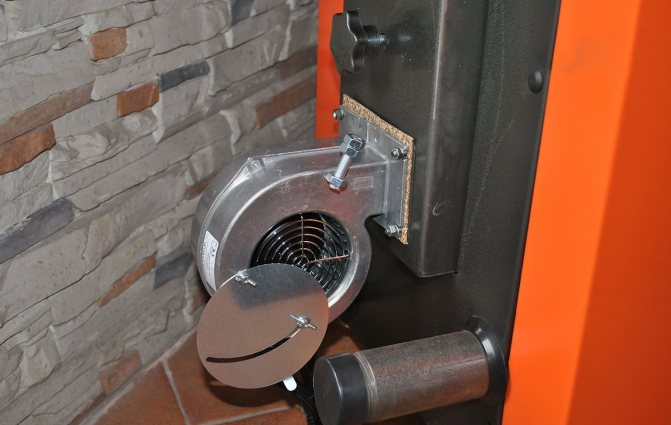

A well-installed blower fan.
The second step is the installation and connection of the automation itself to a solid fuel boiler. The controller is installed on top or on the side of the case through the holes provided for this device. Despite the fact that the body of many controllers is made of heat-resistant materials, it is advisable to install the device on the coldest part of the boiler body, if necessary, place a heat-resistant gasket made of non-combustible material.
It remains only to connect all the elements and connect the controller to the mains. A detailed connection diagram is always indicated in the automation manual, for example, this is how the connection diagram to the Komfort ECO control unit looks like:


Automation connection diagram using the example of Komfort ECO.
How to set up
The detailed tuning algorithm also depends on the model and is always described in the instructions. In general terms, setting implies the following procedure:
- Setting the temperature for turning on the circulation pump - allows you to turn on the pump not immediately, but when the coolant is already warming up, it is necessary to prevent the formation of condensation (usually set at 50 ° C).
- Setting the desired temperature for the heating circuit or room air, depending on the model and controls.
- Setting the fan speed (from 1 to 10) or choosing one of the automatic modes for controlling its speed. With a completely manual setting of the airflow, it is also necessary to set the parameters of the fan operation time and the frequency of its activation in the combustion support mode.
- Fuel filling and boiler firing up. Monitoring its work and, if necessary, adjusting the parameters.
In some models, it is also possible to program the operation for a day or a week in advance, set a temperature threshold, after which the fan will begin to smoothly reduce speed, etc.
Boilers
Instrument selection


Such a device is especially important for those cases when tenants are often absent from home... By connecting this device to the boiler control terminals, outdoor and indoor temperature sensors, it is possible to automatically control the change in the burner operation.
What to look for when choosing a controller:
- Number of componentsapplicable to management. In some models, their number can reach 15.
- Software update rate. Some types of controllers for heating and hot water supply systems are connected directly to a PC, and on the official website of the manufacturer you can always download the latest version of the update.
- GPS unit. If it is included with the controller, it becomes possible to remotely control the heating and hot water supply system.
If you need professional advice in choosing a controller it is better to consult a specialist.
